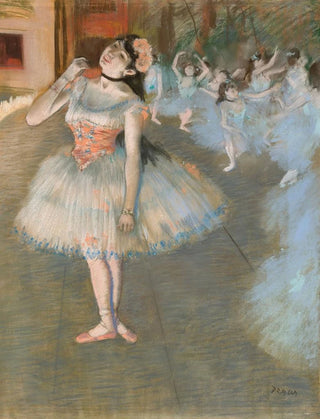Painting L'étoile - Edgar Degas | Art print


View from behind

Frame (optional)
Reproduction L'étoile - Edgar Degas – Captivating Introduction
The artwork "L'étoile" by Edgar Degas, created in 1876, is an iconic painting that captures the very essence of ballet, an art form that fascinates and moves. This painting, which evokes grace and movement, transports us into the intimate world of the Opera's backstage, where dance and light converge to bring a vibrant scene to life. The young ballerina, frozen in a posture that is both delicate and dynamic, embodies the passion and determination of artists seeking recognition. The art print of this piece allows not only for appreciation of Degas's refined technique but also for feeling the emotional intensity it conveys.
Style and uniqueness of the artwork
The uniqueness of "L'étoile" lies in how Degas plays with light and shadow to create a distinctive atmosphere. The pastel colors, delicate and airy, blend harmoniously to give life to a scene filled with poetry. The ballerina, at the center of the composition, is surrounded by a subtle blur that emphasizes her movement, while the dark background highlights her slender silhouette. This contrast between light and darkness is characteristic of Degas's style, who mastered capturing the fleeting moment of a movement, thus paying homage to the ephemeral beauty of dance. The fluid lines and stylized forms testify to his innovative approach, which redefined the depiction of dance in art.
The artist and his influence
Edgar Degas, a major figure of the Impressionist movement, transcended the conventions of his time to offer a new vision of reality. Although often associated with ballet scenes, his work goes far beyond simple representation. Degas was interested in the intimacy of dancers, rehearsals, moments of concentration and preparation, revealing a lesser-known facet of this art. His influence extends well beyond his era, inspiring many contemporary and future artists. The way he captured movement and emotion opened the way to a deeper exploration of themes of performance and identity in art. By celebrating

Matte finish

View from behind

Frame (optional)
Reproduction L'étoile - Edgar Degas – Captivating Introduction
The artwork "L'étoile" by Edgar Degas, created in 1876, is an iconic painting that captures the very essence of ballet, an art form that fascinates and moves. This painting, which evokes grace and movement, transports us into the intimate world of the Opera's backstage, where dance and light converge to bring a vibrant scene to life. The young ballerina, frozen in a posture that is both delicate and dynamic, embodies the passion and determination of artists seeking recognition. The art print of this piece allows not only for appreciation of Degas's refined technique but also for feeling the emotional intensity it conveys.
Style and uniqueness of the artwork
The uniqueness of "L'étoile" lies in how Degas plays with light and shadow to create a distinctive atmosphere. The pastel colors, delicate and airy, blend harmoniously to give life to a scene filled with poetry. The ballerina, at the center of the composition, is surrounded by a subtle blur that emphasizes her movement, while the dark background highlights her slender silhouette. This contrast between light and darkness is characteristic of Degas's style, who mastered capturing the fleeting moment of a movement, thus paying homage to the ephemeral beauty of dance. The fluid lines and stylized forms testify to his innovative approach, which redefined the depiction of dance in art.
The artist and his influence
Edgar Degas, a major figure of the Impressionist movement, transcended the conventions of his time to offer a new vision of reality. Although often associated with ballet scenes, his work goes far beyond simple representation. Degas was interested in the intimacy of dancers, rehearsals, moments of concentration and preparation, revealing a lesser-known facet of this art. His influence extends well beyond his era, inspiring many contemporary and future artists. The way he captured movement and emotion opened the way to a deeper exploration of themes of performance and identity in art. By celebrating
12,34 €






